The Polish Army in Great Britain
With the collapse of French Army and the remnants (some 300,000 soldiers) of the British Expeditionary Force (BEF) rescued from the beaches of Dunkirk
between May and June 1940, the Polish Army fought on and defended their assigned positions until the weight of German forces pressed upon them to surrender
or escape.
On 4th January 1940 General Sikorski and the French Premier had signed a military agreement to form a Polish Army in France.
Despite equipment shortages, it was planned to form 2 infantry corps (Grenadier Division, 2nd Rifle Division, the Independent Rifle Brigade), an armoured division,
up to 20 air force squadrons and auxiliary services.
When war broke out the Polish Army in France numbered 82,000 men from Poland or émigré families. The Grenadier Division was based at
Colombey-les-Belles, southwest of Nancy in Lorraine. The 2nd Rifle Infantry Division (2DSP)
commanded by Brigadier-General Bronislaw Pruger-Ketling was despatched to the front near Belfort. The 10th Motorized Cavalry Brigade under the command
of General Stanislaw Maczek covered the flank near Reims with antiquated weapons. The 10th Motorized Cavalry Brigade consisted of a tank regiment of two
battalions, a motorized cavalry regiment consisting of two battalions, an artillery battery equipped with 105mm and an anti-aircraft troop. Initially moved by rail to
Paris between 27th to 30th May 1940 the Brigade set up its HQ in the château at Corbeville, which was later moved to Orsay. The tank regiment was quickly
moved towards the faltering ‘front’ to Camp de Satory where they were equipped with new Renault R35 tanks while the cavalry took up positions at Arpagon.
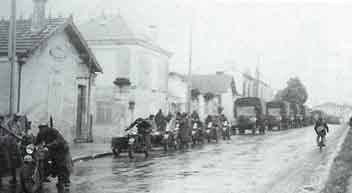
Champagne Region, France 1940
The 1st Grenadier Division in Alsace formed part of the French 20th Corps and while the French army crumbled with troops simply walking away from the fight,
the Poles fought dozens of rear-guard battles in the Moselle area around Diesen on the German border and Lagarde and Raon-L’Etape to the east of Nancy.
The intensity of battle was such that most were killed or taken prisoner.
The 10th Motorized Cavalry Brigade operational area was too vast to be adequately covered and at best could only delay a major assault by providing cover for
retreating units which were under constant attack and bombing. In a charge against the German held town of Champaubert-Montgivroux in the Marne Valley
allowed the French 20th and 59th Infantry Divisions to escape through the St. Gond marshes. On 15th June the brigade crossed the river Seine at Bar sur Seine
to the south east of Troyes in an attempt to get to Chaource for fuel which was in desperate shortage. Having being ordered to take the town of Montbard
situated about half way between Auxerre and Dijon, General Stanislaw Maczek decided upon a surprise attack upon a fortified bridge. They attacked at night the
66th Regiment of the 13th Motorized Division and pushed them back out of the town allowing a French corps to escape along the banks of the Burgundy Canal.
Surrounded, General Stanislaw Maczek ordered all tanks and artillery pieces to be destroyed in the woods at Moloy. With 500 men lightly armed men, General
Stanislaw Maczek escaped to the south seeking ships in the unoccupied ports in order that at a later date re-form in Scotland.
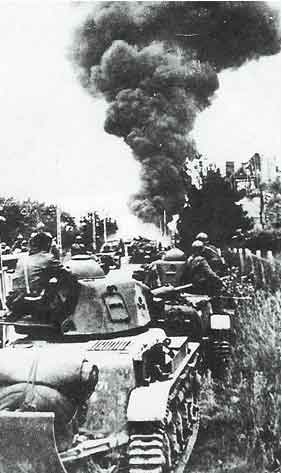
The Attack on Montbard
The surviving of the Polish Podhalanska Brigade returned to France from the Arctic operation at Narvik. They landed in Brest on 13th June 1940 to find that
despite crippling losses of the 1st Grenadier Division covering the allied retreat were ordered to reinforce a non-existent French Army defending Brittany. A few
managed to escape to Scotland to be incorporated into General Stanislaw Maczek’s 1st Armoured Division. The order to sacrifice a combat experienced brigade
and render it ineffective at the fall of France remains one of gross stupidity and incompetence and thereby denied Great Britain a ‘rich’ resource for training less
experienced infantry troops in field-craft being rapidly assembled to fill the losses incurred by the BEF.
Incomplete Polish units in training camps in Brittany had been ordered to disband and disperse south to avoid capture. The Polish Headquarters had moved to
Libourne just outside Bordeaux when General Sikorski arrived on 17th June 1940 to take stock of their position since the French were seeking an armistice with
the Germans. General Sikorski had declined General Weygand’s appeal to throw in all remaining Polish troops into battle. Sikorski appealed in a letter to
Churchill who arranged for him to be flown out of Bordeaux by an RAF plane while the Polish President and members of the government were embarked upon the
British Cruiser HMS Arethuse.
An armada of Polish ships (notably the liners Batory and Sobieski) converged on Marseilles to pluck around 20,000 armed forces personnel to
North Africa.
scotland Scotland 1940
Immediately after the fall of France, Great Britain was on full alert and preparation for the threat of invasion. By July 1940 remnants of the Polish Army were
being assembled and reorganized in the Glasgow area as the 1st Polish Army Corps under the command of General Marian Kukiel. Their duties were building
coastal defences initially along the coast between Fife and Angus and being re-trained on British equipment, which was in desperate short supply. The Island of
Bute became a Polish political detention centre to screen the troops for ‘fifth columnists’ or those who might damage the new strategies being developed by
Sikorski and the Government in Exile (Davies, 2001). Inverlochy Castle near Fort William (STS No.38) was made available for the training of Special
Forces (SF) known as the Cichociemni or The Silent and Unseen (Iranek-Osmecki, 1954).
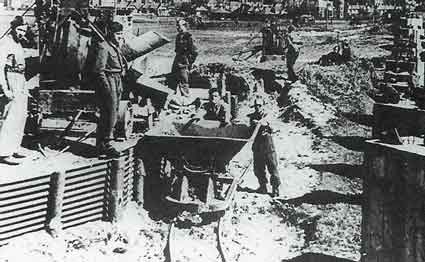
Building Defences – Bunkers and Anti-Tank Obstacles
For some soldiers their campaign odyssey had started in Poland and had taken them via Hungary or Rumania, France and North Africa. Now in Scotland they
were intensively re-trained and within two months had built a defensive perimeter to the north of Edinburgh supported by the Home Guard. Despite call to
arms through the émigré communities in the USA and Canada, the response had been poor and the rebuilding of the Polish Army was slow. It was uncertain
how many Poles were surviving in Vichy France and able to escape.
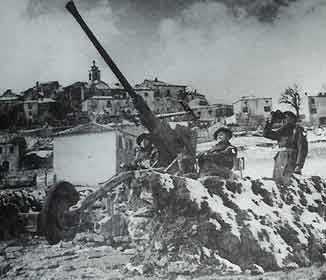
With Great Britain under twin threat initially from the Battle of Britain in August 1940 and possible subsequent invasion through
Operation Sealion, Poland had provided almost 20,000 combat experienced personnel making Poland’s contribution significant. Marshall Goering
planned to use the Luftwaffe to destroy Britain’s airpower and navy paving the way for an invasion fleet to take Dover. Marshall Goering launched
Eagle Day on 13 August 1940 using approximately 1,200 bombers protected by 700 fighters to reduce the Royal Air Force ability be airborne and in
defensive positions by blanket bombing airfields. While ‘The Few’ more than ‘rose to the occasion’ with tragic losses, the German switch to daylight
bombing raids on London on 7th September was a tactical disaster as the Luftwaffe fighters were limited in range and duration to just 20 minutes over
target left the bombers exposed to the RAF fighters. Operation Sealion collapsed and the thousands of barges in Calais and Boulogne harbours and
network of canals in Northern France were redundant.
Once the major threat of invasion was over Britain underwent a radical transformation process in gearing up for its war effort. On 5th August 1940 Poland signed
an agreement with the British Government. The agreement enabled all Polish military forces to keep their national identity and military customs under Polish
command in conjunction with the British War Office and the British High Command to integrate the Poles into the overall war strategy. Under protest by
Sikorski and pressure from Churchill, Stalin released Polish prisoners in the gulags to bolster the Polish Army being formed by General Anders in the Middle
East. General Anders was not satisfied with the numbers released and under constant pressure, Stalin ordered the records to be massaged to show around
475,000 prisoners had been captured despite estimates showing 1.5m to 1.6m had been deported to Russia.
In Scotland the 1st Armoured Division (Dywizja Pancerna) took shape under the charismatic leadership of General Stanislaw Maczek with Colonel Kazimierz
Dworak acting in second in command. Under the guidance and foresight of General Stanislaw Sosabowski, the Polish Airborne Brigade was created on 12th
October 1940.
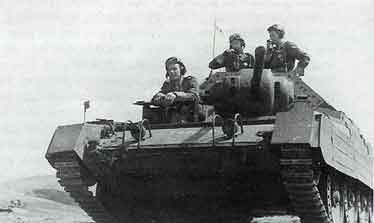
From 1940 until the spring of 1944 a number of re-organizations were made to meet the ‘fine-tuning’ of Operation Overlord. During this period the Polish Army
were able to form:
- 10th Mounted Rifle Regiment (10 Pulk Strzelców) Reconnaissance unit under the command of Major Jan Maciejowski
- 10th Armoured Cavalry Brigade (10 Brygada Kawalerii Pancernej) comprising of the 1st and 2nd Armoured Brigades, 24th Armoured Uhlan Regiment and the 10th Dragoon Regiment
- 3rd Rifle Regiment (3 Brygada Strzelców) which included the 5th Podhale Rifle Regiment commanded by Colonel Marion Wieronski
- 8th and 9th Rifle Battalion which included the Heavy Machinegun Independent Squadron
- Artillery Division comprising of 1st and 2nd Motorized Artillery Regiment and commanded by Colonel Stanislaw Noël
- 1st Anti-tank and 1st Anti-Aircraft Regiment
- Sapper Unit which included 10th and 11th Sapper Companies and included the 1st Bridge platoon and auxiliary company led by Lt. Colonel Jan Dorantt
- Lt. Colonel Jan Grajkowski commanded the Communications Battalion that included 1st, 2nd, 3rd and 10th Communications Squadrons that were responsible for repairs, supply and sanitation materials.
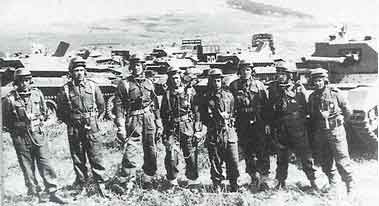
Training in Scotland
In May 1943 1st Armoured Division left Scotland via Pickering Army Depot and arrived at Chippenham near Newmarket in Suffolk to undergo five months of
intensive training on Cromwell tanks. These exercises were carried out on the Suffolk heath land and designed to simulate the open countryside of northern France
and bore no resemblance to the ‘Bocage’ of Normandy, which was later to prove a disaster in the making for the US Army under Patton.
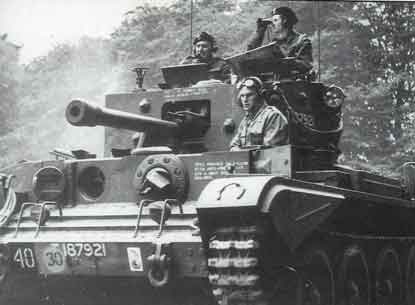
General Stanislaw Maczek – Newmarket, Suffolk
Operation Overlord
The Polish 1st Division had been attached to the 1st Canadian Army whose role was designated to form part of the bridgehead to storm the city of Caen. The
Polish 1st Division’s role was to be in later stages of the invasion to support the build up sufficient strength in the bridgehead behind the beaches to allow the
breakout and push for the strategic city of Caen.
Juno Beach was made up of two sectors: Mike and Nan. Juno was the second most heavily defended (after Omaha) of the beaches chosen for the landings
with the Canadian 3rd Division (including the 2nd Canadian Armoured Brigade) responsible for capturing and securing the beach and headlands between Saint
Aubin-sur-Mer in the East to Courseulles Sur Mer in the West. The German defenders had caused terrible casualties to the first waves and as the tide rose, the
Allied landing craft had become entangled with the anti-invasion obstacles and mines. Military planners of Operation Overlord had designed the invasion for
tanks to follow infantry waves and this may have led to higher levels of casualties than planned, as there was a lack of close quarter suppression fire. British Royal
Marines manned obsolete Centaur tanks fitted with 95mm howitzers for close artillery support on landing, however, these proved to be ‘lethally un-seaworthy’ in
landing craft with only about 15% successfully embarking (Hastings, 1999). It took about 3 hours to capture Saint-Aubin-sur-Mer with about a 50% casualty
rate.
The Canadian 3rd Division formed part of the British 2nd Army and their dash for Caen was one of the most ambitious plans. The Canadian 3rd Division inland
push stalled at Carpiquet as they took the brunt of the counter attack by the formidable 12th SS Panzer. With the beaches ‘clogged up’ and subsequent waves
being re-designated to clearing pockets of tough resistance. The 12th SS Panzer under the command of Colonel Kurt (Panzer) Meyer fought resiliently and
improvised at every opportunity to keep up momentum to drive the Canadians back into the sea, however, the Canadian 9th and 7th Brigade fought a series of
tough counter attacks and dug in and consolidated their positions.
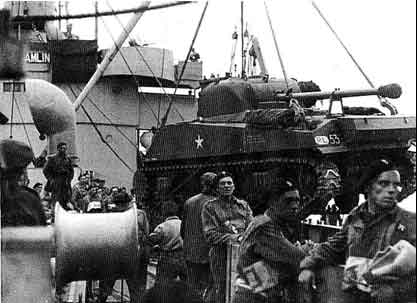
1St Division Sherman Firefly being unloaded
The first units landed on the Normandy beaches on the 30th July 1944 (D-Day + 54) at Courseulles Sur Mer on Juno Beach. Their eventual objective was to
seize the Falaise area and link up with US forces near Argentan, which would bottle up German forces in the peninsular and cut off any retreat. However, the
Normandy campaign to prove to be tough and the failure to capture Caen delayed the breakout by almost six weeks and it also denied the Allies to breakout into
the more open countryside suitable for tanks.
Montgomery made 3 attempts to take Caen. The first attempt was direct attack as part of and continuation of the invasion (Overlord) strategy on 7 – 8th June.
The second attempt was to envelope Caen through the bypassing swing towards Villers-Bocage on 13th June and then finally Operation Epsom on 25th June.
US forces had been designated the port of Cherbourg and the clearing of the Cotentin Peninsula (Operation Cobra) which was not achieved until 27th June. The
US fighting in the bocage countryside was to be remembered by bitter fighting for feet rather than yards in small fields and sunken lanes, which brought
comparisons to the Great War. The German defence utilizing these natural features, counter-attack strategies and planned with-drawls to pre-prepared positions
has been textbook material for future generals to study. Once St. Lô had fallen, Patton was able to breakout into the Loire valley.
Meanwhile, Montgomery’s push for Villers-Bocage had been slow and achieved none of its objectives. Operation Epsom on 26th June became a debacle with
heavy casualties. The whole of the VIII Corps launched an attack on a 6Km front between the villages of Carpiquet and Rauray through thickly wooded areas
towards the river Odon and southwest Caen in an attempt to encircle the city. The fierce battle was reminiscent of Passchendaele with attacks repulsed by fierce
counter-attacks and the operation stalled by 1st July.
Montgomery launched Operation Goodwood 18 -20 July in order to capture all the river crossings along the river Orne from Caen to Argentan. To the dismay
of commanders like General ‘Pip’ Roberts of the 11th Armoured Brigade, the infantry and armoured divisions would have separate objectives and commanders’
requests to use self-propelled guns to assist in the rapid transport of infantry being denied, caused deep concerns. Vast bomber support to hit targets of Panzer
Group West failed to destroy equipment and the resilience of the well dug in defenders whose equipment superiority and effective use inflicted high casualty rates
and again the momentum of battle was lost. Goodwood failed its objectives to the loss of 400 tanks and 5,537 casualties.
The Polish 1st Division was directed towards Bayeux to build up the Division between late July and 7th August 1944 along side the Canadian 4th Armoured
Brigade. Montgomery had underestimated the strength of the 12th SS Panzer and 21st Panzer holding a line in front of Caen (Hastings, 1999) and so to avoid
high casualties had swung the attack around Caen towards Villers-Bocage.
For the Polish 1st Division their ‘jump-off’ was on the night 7th - 8th August as part of Operation Totalize. With the Canadian II Corps they were to advance
along the Caen –Falaise road. After the infantry divisions of the 21st Army had attacked, the armoured units moved forward despite ‘friendly fire’ caused by
US bombers hitting the divisional artillery. By mid-day infantry had captured a swathes of countryside and surrounding towns from Fonteney to
Tilley–la–Compagne while to the south of Caen the two armoured divisions had met heavy resistance and the 1st Division had lost 40 tanks and the momentum
was lost 50km short of Falaise.
The Polish 1st Division was ordered back into operation on 10th August 1940 as part of Operation Totalize. Operation Totalize opened up at 23.00 hours on
7th August with over a thousand Lancaster and Halifax bombers carpet-bombing the Canadian/ Polish flanks between La Hogue and Mare de Magne in the east
and Fonteney le Marmion and May sur Orne in the west shattering the German 89th Division. The Poles objective was to capture Hill 111 and the Chemi-Hausse
woods and then spent the next two days holding the line against heavy counter-attacks. Operation Totalize dwindled much to Montgomery’s chagrin and this left
opportunities for the Germans to reform their defensive lines along the River Laison.
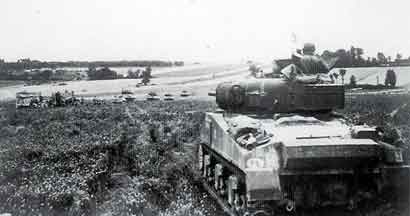
Operation Tractable was launched on 14th August in an attempt to trap the German army in a pocket. The 2nd Canadian Division advanced in thick clouds of
dust caused by the advancing armour making navigation almost impossible. Momentum was lost at the River Laison which acted as an effective anti-tank ditch
and more tragically Bomber Command made up of Canadian Squadrons mistook yellow flares for enemy positions and bombed their own ground forces with
over 300 casualties (Hastings, 1999). Montgomery and Patton needed the pocket to be closed and not allow the German Army to escape through a narrowing
corridor near Falaise.
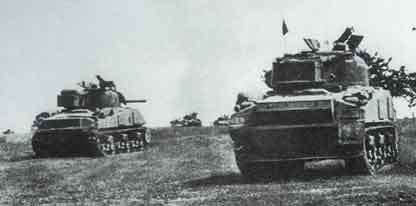
On 15th August the Canadian and Polish armour were ordered to swing southeast for Trun to seal the pocket and just crossed the River Dives as Falaise was
cleared of the fanatical Hitler Youth who had defended the town to the last. The Polish 1st Division (2nd Armoured Regiment) was ordered to push towards
Chambois at all costs in order to close the pocket. Delays and confusion over orders meant the 2nd Armoured Regiment left early on 18th August towards Les
Champeaux before turning towards Chambois where the gap was just a few thousand metres with German units fleeing through an alley strewn with mangled
bodies and machinery of war. Allied fighter-bombers flew 2-3,000 sorties a day inflicting massive losses while artillery poured shells into the valley below.
The 2nd Armoured Regiment and the Canadian 4th Armoured Brigade were under constant and ferocious counter attacks by the 2nd SS Panzer. Having
captured Mont Ormel (Hill 262), the Poles held the line and blocked the German 7th Army escaping. In effect 1,500 Poles and 80 tanks were cut off at Mont
Ormel from 19th to 22nd August and fought ‘with a fury uncommon even by the standards of Normandy. Poles and Germans detested each other with
real passion, and each believed that they had much to avenge, the Poles with better reason’ (Hastings, 1999: 357).
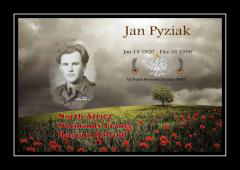
For LCPL Jan Pyziak 1st Polish Armoured Division, 8th Regiment, he spilled his blood during the battle during the Battle of the Falaise Pocket. "He was in the battle to capture Hill 262. His unit got the nickname the "Bloody Shirts" of the Black Devils Brigade because every soldier was covered in blood. My Dad was stuck on that hill for 72 hours fighting Nazi SS troops in hand to hand combat until his unit was rescued by Canadian Soldiers".
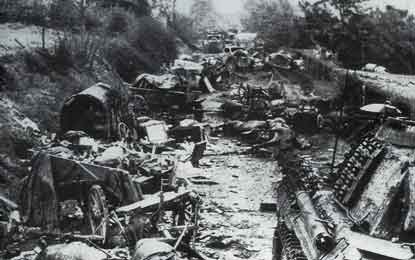
General Stanislaw Maczek had recognised the strategic importance of Mont Ormel and his decision to hold the escarpment and then descend into the valley to
capture Chambois in effect closed the pocket. They had captured 150 Officers, 5,500 POWs,
destroyed 70 tanks and another 500 vehicles.
From 23rd until 28th August 1940 the Polish 1st Division was put into reserve. They were based at Mesnil / La Brouay to the East of Caen for a refit/ re-arm and
some time for R&R (rest and recreation).
The March to Germany
Top of Page
|